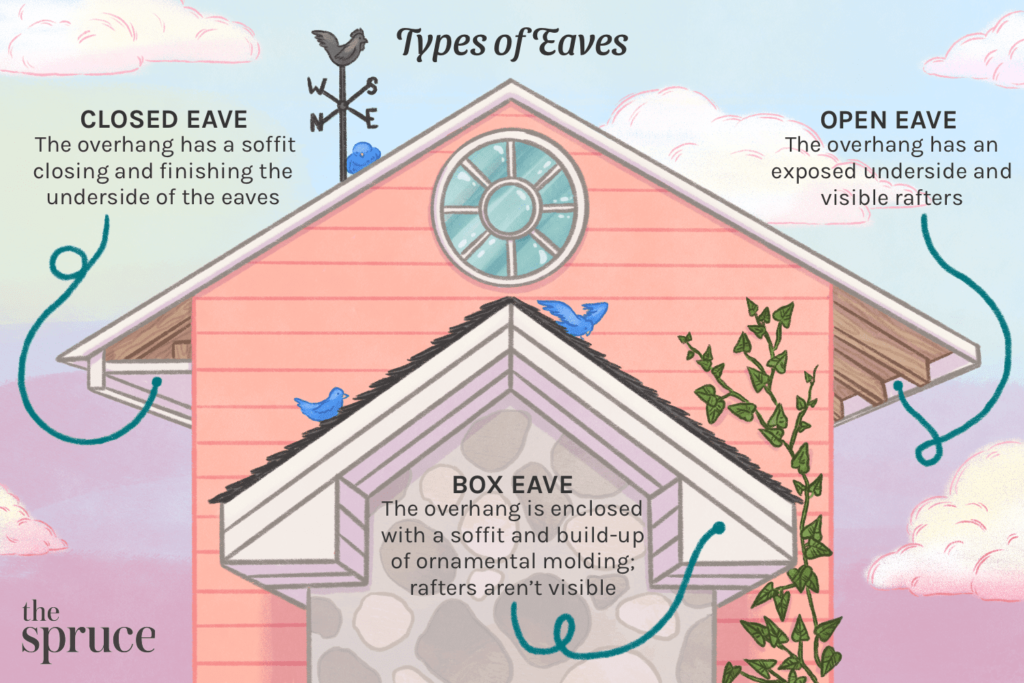Understanding Roof Eaves: An In-Depth Analysis

Welcome back to Brehm Roofing’s expert insights. Delving deeper into the architectural marvels of roof eaves, we explore the critical components and the types of eaves, focusing on their advantages and why builders might favor one over another. Our aim is to provide a comprehensive understanding that aids in making informed decisions about your roofing needs.
Recognizing the Significance of Roof Eaves in Home Maintenance
After understanding the basic premise of what a roof eave is and its location on the roof, it’s important to delve into the practical implications for you as a homeowner. A roof eave extends beyond the side walls of a house, providing crucial protection for the structure’s siding and foundation by directing water away from the building. This feature is typically found along the lower edges of the roof and can be easily spotted as the overhanging section. Knowing the location and condition of your roof eave is vital because it plays a significant role in the overall health of your home. It prevents water from seeping under the roofing material, which can lead to costly damage such as mold, mildew, and structural decay. Additionally, well-maintained eaves contribute to attic ventilation, reducing the risk of ice dams in colder climates and lowering energy costs by aiding in temperature regulation. Understanding the state of your roof eave can empower you to spot early signs of wear and address them promptly, ensuring your home remains safe, efficient, and aesthetically pleasing.
Fascia and Soffit: The Dynamic Duo
Fascia is the visible, vertical finishing edge that attaches to the ends of the rafters. It acts as a layer between the outdoors and your roof edge, protecting the wooden board against water damage. Moreover, it provides a point of attachment for the gutters and other roofing materials.
Soffit is the underside component of the eave, forming a ceiling from the top of the exterior house wall to the outer edge of the roof. Ventilated soffit plays a crucial role in circulating air to the attic, reducing the heat and moisture levels that can cause raft rot and decay in rafters and sheathing. A well-installed soffit can provide a long-lasting defense against weather damage.
By understanding the roles of fascia and soffit, one can appreciate their necessity in maintaining the roof’s integrity and the overall aesthetic of the house.

Delving into Eave Types
- Open Eaves: Open eaves present an opportunity to showcase the structural elements of your roof with visible rafters and beams. They can offer a rustic or artisanal look to the building’s architecture. This style allows for more ventilation and is often easier to inspect and maintain since the structure is visible. Roofing contractors might choose this for its simplicity and the traditional charm it lends to a home.
- Closed Eaves: Closed eaves are characterized by the soffit that encloses the underside of the eave. This style provides a sleek and finished look, preferred in modern residential designs. They offer better protection from the elements and can be used to conceal ventilation systems and insulation. Roofing contractors often opt for closed eaves for their neat appearance and the added layer of protection against pests and moisture.
- Box Eaves: Box eaves are more complex and are often used in designs that call for a detailed and ornamental appearance. The overhang is enclosed with a soffit and often embellished with molding or additional trim. This type of eave can provide a sophisticated look to the building and is often chosen for its aesthetic appeal. The enclosed design also offers excellent protection and insulation.
The Importance of Proper Eave Installation
As noted by Mike Guertin in ‘Roofing With Asphalt Shingles, the choice and installation of drip-edge style are crucial. He states, “The most common drip-edge style used along eaves is an extended drip edge; so named because it supports the butt edge of shingles where they extend beyond the roof and fascia.” This extended support is vital for durability and longevity of the roofing material, especially in areas prone to heavy rain and wind.
In contexts where a sidewall extends beyond an eave, Guertin emphasizes, “Where a sidewall extends beyond an eave, the bottom piece of step flashing has to prevent the water from getting into the wall behind the siding.” This insight underscores the importance of detail in eave construction to ensure the home is fully protected from water damage.
Conclusion: Brehm Roofing’s Assurance
At Brehm Roofing, we understand that the choice of eaves, along with proper installation of fascia and soffit, is vital to the structural integrity and aesthetic value of your home. We specialize in reroof services, including the careful installation of new fascia and soffit on the eaves. With our team’s expertise, you can rest assured that your roofing needs will be met with the highest standards of quality and professionalism. Contact us today to ensure your home is as beautiful as it is durable.
